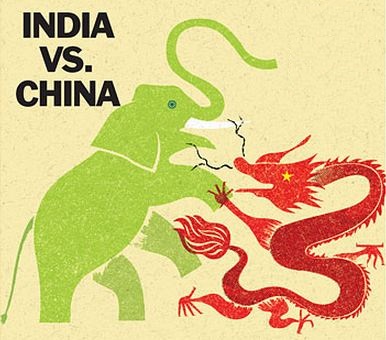 China and India, two of the world’s oldest civilizations, are also two of the fastest growing. Until the year 1000 AD, China and India accounted for a quarter and a third, respectively, of all economic activity in the world.
China and India, two of the world’s oldest civilizations, are also two of the fastest growing. Until the year 1000 AD, China and India accounted for a quarter and a third, respectively, of all economic activity in the world.
By the time the Industrial Revolution took hold in the late 19th century, however, both India and China had lost the economic and geopolitical relevance they’d enjoyed during the first millennium AD. Both declines were largely a result of China and India not adopting Industrial Revolution-era technologies and innovations, from which Japan and Western Europe experienced rapid growth and progress.
Today, China and India have re-emerged as world economic powers. Most economists believe India and China were able to make a comeback because both countries have become more fully integrated in the global economy during the last 20-30 years. During this period, they have also benefited from the kind of knowledge-sharing made possible by the digitally-connected world. China’s admission to the World Trade Organization in 2000 was seen by many analysts as symbolic of China’s rise to global prominence.
As China’s growth has slowed, policymakers have tried to steer the country away from investment, in favor of consumption. In India, meanwhile, economic reforms implemented in the early 1990s have eliminated many of the burdensome trade regulations that stymied India’s economic activity in the past. The Indian government attributes India’s accelerated growth to these economic reforms.
The “China versus India” debate has been going on for some time now; each country has its own unique heritage and strengths. Examining the innovative capacity of each country may provide further insight when it comes to predicting the economic potential of both India and China in the long term. Taking this approach, here’s my brief take.
Indian Prime Minister Narendra Modi has instituted a number of policy initiatives that will be conducive to India’s continued development and economic growth. Prime Minister Modi has also prioritized policy reforms that ultimately will benefit India’s national business environment, its infrastructure, and its young workforce.
But, in areas such as health, education, and labor market rankings, India lags behind China. Although India’s current economic growth rate is higher than China’s, India has struggled in the past to sustain periods of economic growth.
In order for India to achieve global status and power–the kind that China appears to be approaching–India must also take measures to ensure its growth and education reforms are inclusive. China has advanced much more rapidly than India has in this regard, with literacy and overall educational attainment rates in China improving along an upward trend. Moreover, India still suffers from fragmentation among competing power centers in New Delhi and its 29 states, and across most metrics India shows higher levels of corruption than does China.
India has started to implement policies that specifically target social capital development; India has also implemented additional market reforms to remove institutional and socio-cultural barriers that currently prevent India’s poorest citizens from participating in the labor force. These are positive developments that will benefit India in the long run. And unlike China, India will not have to confront the impending demographic challenges that China will soon face, as it gets old before it gets rich.
I am not a betting man, but if I were, I would think that in ten years’ time, India will still lag behind China economically. But, on a more long term scale–say, 25 years from now–I believe the two countries may reverse roles. Whatever the future has in store for China and India, these are two ancient cultures that clearly are and will be back on the world stage for years to come.
